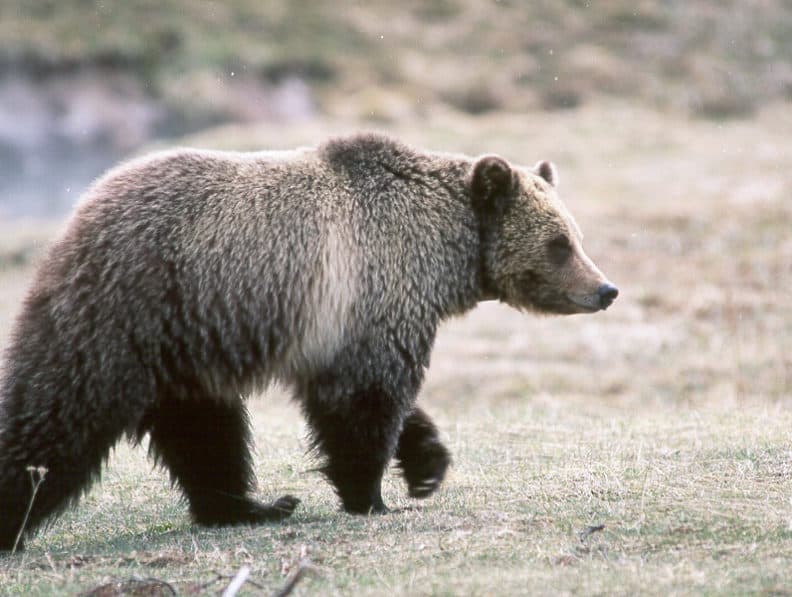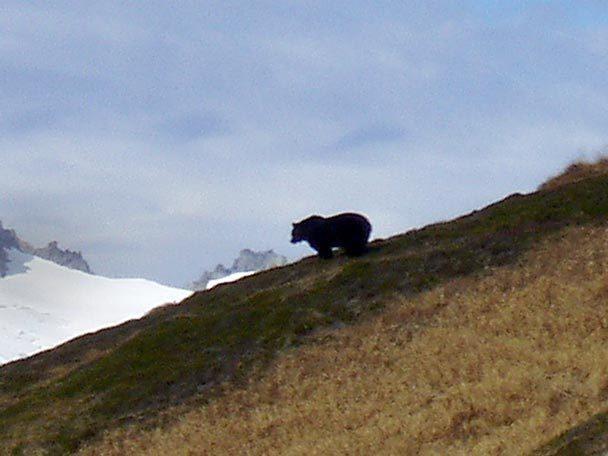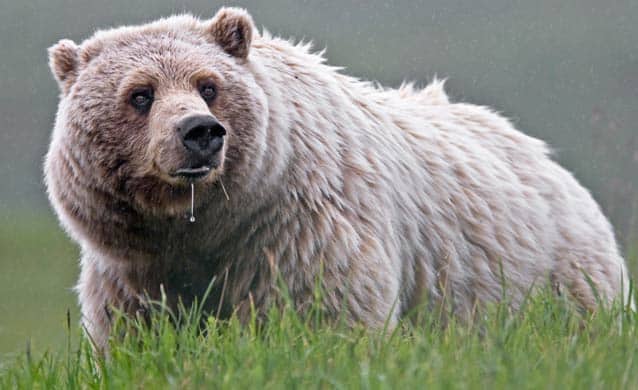
The North Cascades Grizzly Bear: Threatened Past and Uncertain Future
This Naturalist Note was written by graduate student Eric Buher, as part of the as part of the Fall Natural History Project In North Cascades Institute’s M.Ed. Residency coursework. You can view other students’ work here.
Take a moment to imagine a grizzly bear ambling free through an alpine meadow, down a rocky slope, or along a salmon-filled creek. You may conjure images of the old west, of fierce mountain men trekking their way through harsh and unforgiving wilderness. Some revere the savage majesty of the “great bear,” while others fear its presence in the lands they frequent.
Bear tourism annually brings visitors to Yellowstone National Park. It is a growing industry in the Canadian Wilderness and on the Alaskan Frontier, where guides charge top dollar for the chance to see this charismatic omnivore in its home range. Despite the apparent popularity of the grizzly bear, it has a troubled history. Particularly in the North Cascades, the so-called “ghost bear” is in dire need of understanding and protection.
Not long after Lewis and Clark first explored the area, fur traders made it to the future Washington State. From 1827 to 1859, records show that 3,788 grizzly hides were shipped out by Hudson’s Bay trading posts alone. Likely, between 600 and 800 of those came directly from the North Cascades. Hunting for sport, profit, or protection continued well into the 20th century. In 1967, the last grizzly bear legally killed in the North Cascades was shot in Fisher Creek Basin. The next year, Congress created the North Cascades National Park and hunting was no longer allowed.
In 1973 Congress passed the Endangered Species Act; two years later the grizzly bear was listed as threatened with extinction in the contiguous United States. Four recovery ecosystems were designated, all in the Rocky Mountains, the most well-known of which was centered on Yellowstone National Park. In 1984, three new ecosystems were chosen for evaluation as recovery zones, including the North Cascades. After extensive study and planning, the Bitterroot Ecosystem and the North Cascades Ecosystem (NCE) were formally added to the Grizzly Bear Recovery Plan in 1991.
Biologists spent many years seeking out existing grizzly bears, with little success. Despite that, efforts today are ongoing. Sporadic reports and signs of grizzly activity keep hope alive. Based on such evidence, the official population estimate in 1991 was 10 to 20 bears. The last confirmed sighting of a grizzly bear occurred in 1996 near Glacier Peak.

Most recently, in 2011, a hiker submitted a photo of a suspected grizzly bear moving along a ridge south of the North Cascades Highway. Although initially confirmed as a grizzly, subsequent photo submissions made the actual species unclear.
In 2014, after 23 years of government inertia, funding was finally approved to begin writing an Environmental Impact Statement for grizzly bear augmentation in the NCE. The draft of that document (available here) was posted for public comment in January 2017. More than 100,000 comments were received before the end of the public comment period in April.
Despite this exciting progress, the next steps are unclear. Comments need to be read and addressed, and a final action plan must be selected. Before any augmentation efforts can begin, final approval must be given by the Fish and Wildlife Service, which has no confirmed director as of the end of 2017.
(Update July 2018: Efforts to restore grizzly bears in and around Washington’s North Cascades National Park have resumed after Department of the Interior officials put the process on hold last December. “Restoring the grizzly bear to the North Cascades Ecosystem is the American conservation ethic come to life,” Interior Secretary Ryan Zinke said on Friday during a visit to North Cascades National Park headquarters. Read more here.)
It has been 26 years since the NCE became part of the Grizzly Bear Recovery Plan and 21 years since a verified grizzly has been sighted. The public has been educated and backwoods camping sites have become more bear-friendly, but we have yet to see any action taken to help the grizzly population expand. Currently, the population estimate is less than 10 bears; not sustainable, and probably not reproducing at all.

The grizzly bear as a species is in no danger of becoming extinct. Alaska hosts a population of 30,000 bears and Canada is home to 25,000. In the lower 48, however, there are less than 2000 grizzlies. Most are found in the Greater Yellowstone Ecosystem (approx. 700) and the Northern Continental Divide Ecosystem around Glacier National Park and the Bob Marshall Wilderness (approx. 1000). The North Cascades Ecosystem has everything a grizzly needs to succeed except, perhaps, for the bear itself.
In 1973 the American people made a profound commitment to protect all species and the habitats they need to thrive. For the grizzly bear, only time will tell if we can live up to that responsibility.
Read North Cascades Institute’s statement in support of returning the grizzly bear to the North Cascades here. For more natural history information, check out this informative series elsewhere on our blog.


It hasn’t been 21 years since a verified sighting. A sow and her cub were spotted near Conconully last September.
http://hunting-washington.com/smf/index.php/topic,217875.0/topicseen.html